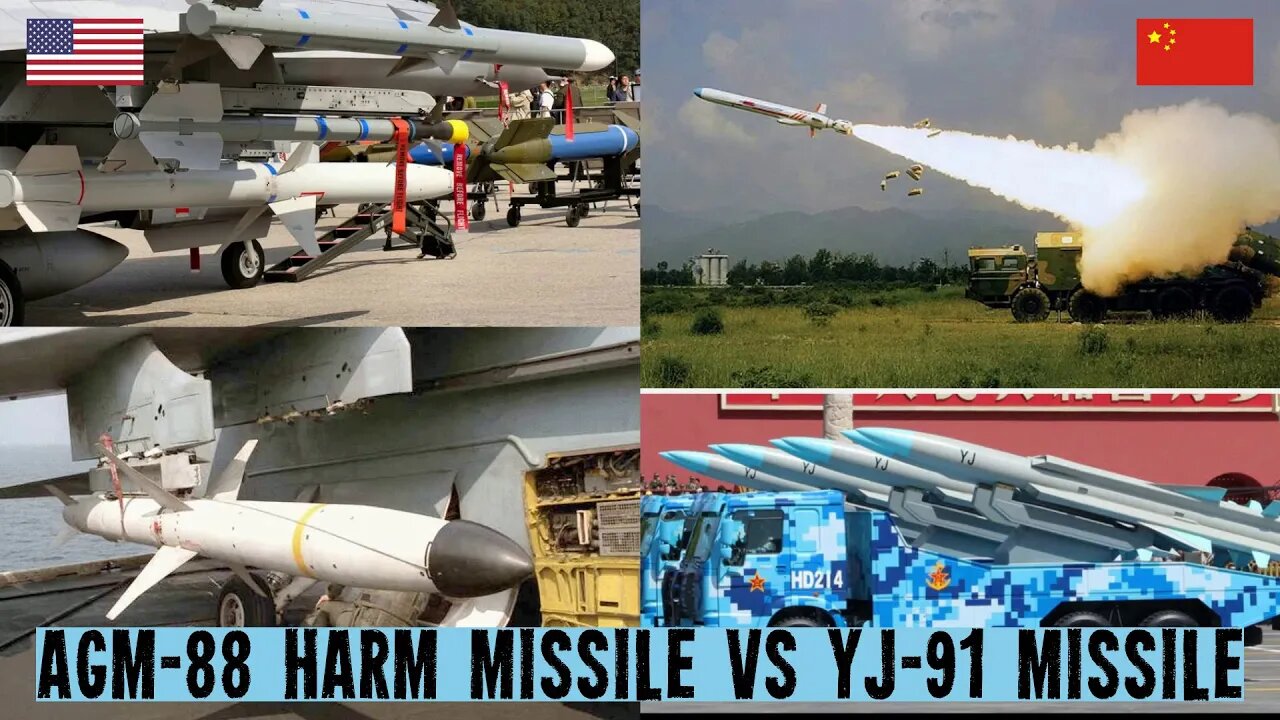Premium Only Content

AGM-88 HARM Missile Vs. YJ-91 Missile #usa #china #usvschina
Connect with us on Facebook: https://www.facebook.com/profile.php?id=100087951995959
Twitter: https://twitter.com/shieldwall_d
When it comes to air-to-surface missiles, two models stand out: the U.S. AGM-88 High-speed Anti-Radiation Missile (HARM) and China's YJ-91 missile. Both missiles have been meticulously developed by their respective nations to provide tactical superiority and advanced capabilities. The debate over their relative efficiencies is ongoing. This article delves deeply into a comprehensive comparison of the AGM-88 HARM and the YJ-91, assessing various elements including design, capabilities, range, guidance systems, and integration with other military systems. The examination aims to offer a better understanding of the missiles’ effectiveness and their roles in modern warfare.
AGM-88 HARM.
Developed by the United States, the AGM-88 HARM has been a critical asset in suppressing enemy air defenses. Operational since the 1980s, it is designed to home in on enemy radar systems, destroying them and thereby blinding enemy air defenses. The AGM-88 HARM has a robust design with a focus on speed, range, and resilience. The missile can travel at speeds exceeding Mach 2, with a range of over 150 kilometers. It uses a passive radar homing system, enabling it to lock onto enemy radar emissions and follow them to the source. This system allows for precise targeting of enemy radar installations, minimizing collateral damage. Integration with various U.S. aircraft, such as the F/A-18 Hornet and the EA-18G Growler, allows for seamless operation and flexibility for the AGM-88 HARM. Having served as a trusted weapon in the U.S. military’s arsenal for decades, the AGM-88 HARM's performance has been tested and proven in a variety of conflict zones. From its initial deployment during Operation Desert Storm in 1991 to later uses in Bosnia, Kosovo, and even more recently in the Middle East, its efficacy in suppressing enemy air defenses is notable. One significant instance showcasing the AGM-88’s capabilities was during Operation Allied Force in 1999. NATO forces employed the HARM to suppress and neutralize Serbian air defenses, paving the way for other strike aircraft to operate with decreased threat levels. The missile's ability to lock onto enemy radar signals, even when those signals are turned off momentarily to avoid detection, has made it a feared weapon amongst adversaries. While the AGM-88 HARM is formidable, it isn’t without its challenges. Advanced countermeasures developed by potential adversaries can pose threats to its operational success. Digital radio frequency memory (DRFM) jammers, for instance, can confuse the missile’s passive homing system by replaying the radar signals with a slight delay, thus leading the missile astray. Moreover, the growth of stealthy radar systems and the increased use of mobile radar units can present detection and targeting challenges for the AGM-88. An enemy's ability to rapidly reposition radar units and then switch them off can reduce the HARM's effectiveness.
YJ-91.
China's YJ-91, while less publicly analyzed, is believed to possess similar anti-radiation and anti-ship capabilities. China purportedly developed the YJ-91 with technology assistance from Russia, making it a modern missile system with advanced features. The YJ-91, on the other hand, is noted for its stealth features and advanced guidance systems, enhancing its ability to evade enemy defenses and strike its targets effectively. It also employs advanced guidance and navigation systems, rumored to include both passive and active radar homing, giving it potential versatility in engaging different types of targets. The YJ-91’s compatibility with various Chinese aircraft and naval platforms further expands its operational scope and utility. The YJ-91, on the other hand, hasn’t been as extensively battle-tested as the AGM-88 HARM. However, its design and purported capabilities position it as a worthy counterpart in theoretical scenarios. Given China's increasing naval and aerial assertiveness in regions like the South China Sea, there's anticipation surrounding how the YJ-91 might be employed in potential future conflicts.
====================================
#shieldwall #shieldwalldefense
We appreciate all of our viewers and supporters. Thank you.
====================================
Fair use is the right to use a copyrighted work under certain conditions without permission of the copyright owner. The doctrine helps prevent a rigid application of copyright law that would stifle the very creativity the law is designed to foster. It allows one to use and build upon prior works in a manner that does not unfairly deprive prior copyright owners of the right to control and benefit from their works. Together with other features of copyright law like the idea/expression dichotomy discussed above, fair use reconciles the copyright statute with the First Amendment.
====================================
-
 LIVE
LIVE
The Bubba Army
22 hours agoWander Franco found GUILTY! - Bubba the Love Sponge® Show | 6/27/25
2,039 watching -
 1:58:00
1:58:00
Nick Freitas
13 hours agoFeminism Is Killing Society
10K16 -
 22:17
22:17
Clownfish TV
21 hours agoThe Ironheart Narrative Begins...
13.6K7 -
 LIVE
LIVE
BEK TV
23 hours agoTrent Loos in the Morning 6/27/2025
207 watching -
 9:53
9:53
MattMorseTV
20 hours ago $20.20 earnedCNN just made a FATAL MISTAKE.
64.8K69 -
 25:23
25:23
Uncommon Sense In Current Times
17 hours ago $1.94 earnedInside Iran: Lana Silk on the Underground Church, the Islamic Regime & the Fight for Freedom
21K3 -
 12:59
12:59
Actual Justice Warrior
17 hours agoDemocrat Calls For Gangs To ATTACK ICE
17.7K19 -
 34:18
34:18
Athlete & Artist Show
4 days ago $1.99 earnedPanthers Win BACK 2 BACK, Bennett Wins Conn Smythe, Can Florida Keep The Rat Pack?
21.8K1 -
 23:08
23:08
DeVory Darkins
1 day ago $6.79 earnedCNN suffers HUMILIATING SETBACK after Iran confirms damage to nuclear sites
23.4K98 -
 8:09
8:09
Nate The Lawyer
1 day ago $2.06 earnedKarmelo Anthony Indicted for First‑Degree Murder Facing Life In Prison
19.7K11